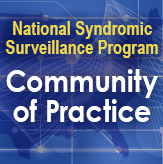Kansas Uses Syndromic Surveillance Data to Educate the Public and Providers about Rabies
Infectious Disease

Rabies, a virus spread to people by infected animals, is nearly 100% fatal once symptoms appear. Officials in Kansas noticed an increase in calls and emails to the health department about rabies and turned to syndromic data to get a clearer picture of the issue. Syndromic surveillance records data when a person visits the emergency department for possible rabies exposure. Examining the data showed an increase in people seeking care for bat exposure.
Rabies is treated using post-exposure prophylaxis (PEP). For healthcare providers, deciding to give a patient PEP is complex, as it is a limited and costly resource. With the increase in cases, health officials implemented educational awareness campaigns for Lawrence-Douglas County area residents about bat exposure and for healthcare providers about when to pursue rabies PEP and who to contact for help.
These campaigns proved successful in directing both concerned residents and healthcare providers to the local health department to help guide decision making about when to administer PEP. Funding from the National Syndromic Surveillance Program supports the use of syndromic surveillance in improving the nation’s public health.
Public Health Problem
Rabies is caused by a virus spread to people from the saliva and neural tissue of infected animals. The most common mode of transmission is through the bite of a rabid animal; however, rabies can be transmitted through non-bite exposures (e.g., transplant of organs or tissue, contamination of mucous membranes with saliva or neural tissue from an infected animal). Rabies has been recognized throughout history due to its neurotropic nature and because it is nearly 100% fatal following symptom onset. In humans exposed to rabies, infection can be prevented by immediately washing the wound and proper post-exposure prophylaxis (PEP) treatment: rabies immunoglobulin (IG) and rabies vaccine.
In Kansas, suspected or confirmed rabies in humans and confirmed rabies in animals are reportable. However, the administration of rabies PEP is not a reportable condition. For example, if a person is exposed to a bat and visits the emergency department (ED) for rabies PEP—but the bat was never tested for rabies—most likely, this would not be reported to local or state public health. Rabies PEP is administered at hospital EDs as rabies IG, and it is only available at these facilities for most counties in Kansas, including Douglas County.*
Actions Taken

When exposure occurs, the likelihood of rabies infection varies with the nature and extent of exposure. Under most circumstances, two categories of exposure (bite and nonbite) should be considered.1 Staff at the Kansas Dept. of Health and Environment will assess the type of animal responsible for the exposure. Bats are increasingly being implicated, with transmission occurring from what looks like a minor bite.2
1 CDC. Rabies. What type of exposure occurred? [online]. 2011. [cited 2018 Aug 1]. Available from: https://www.cdc.gov/rabies/exposure/type.html
2 KDHE. Rabies Investigation Guideline [online]. 2017. [cited 2018 Apr 5]. Available from: http://www.kdheks.gov/epi/Investigation_Guidelines/Rabies_Disease_Investigation_Guideline.pdf
Administration of rabies PEP is an essential aspect of rabies surveillance and important to the Lawrence-Douglas County Health Department (LDCHD). Knowing how many people get rabies PEP provides an indication of the public’s level of concern about rabies and potentially rabid animals in the community. Because rabies IG is administered only at the ED in Douglas County, the ESSENCE** system, which pulls chief complaint and diagnosis code data from EDs, makes an ideal tracking mechanism for rabies PEP. LDCHD used queries and dashboards developed by the Kansas Department of Health and Environment Kansas Syndromic Surveillance Program to begin tracking the administration of rabies IG on July 7, 2017.
In August 2017, the LDCHD’s communicable disease staff noticed an increase in calls and emails to the health department about rabies—specifically, exposure to bats. LDCHD staff document disease investigations, animal complaints, and food complaints in an Access database, allowing for activity comparisons by month and year. The number of rabies-related calls and emails appeared higher than previous months and years, so LDCHD communicable disease staff considered whether to implement public health outreach, education, or other campaigns. By using rabies queries in ESSENCE, LDCHD found more persons receiving rabies PEP than anticipated. Further, by assessing the chief complaint, the local health department realized most complaints involved bat exposures. For example, in July 2017, one person sought care at the ED for bat exposure, but in August 2017, five people sought care for a bat exposure. In addition, the LDCHD communicable disease staff compared the number of people who sought care for a bat exposure at the ED in August 2017 (5 people) to the number of people who sought care for a bat exposure in August 2016 (2 people), which showed an increase between the two years.
After enlisting help from the LDCHD communications coordinator, LDCHD communicable disease staff decided to implement a campaign for area residents about bat exposure. The message was designed around what to do if someone was exposed to a bat and, specifically, information about calling the local health department for assistance. Another action of the education campaign targeted healthcare providers, including information on when to pursue rabies PEP and who to contact for technical assistance. Many factors need to be considered when determining if rabies PEP is warranted because rabies PEP is a limited and costly resource, which can deter vulnerable populations without health insurance. Also, some people can have adverse reactions to the vaccine and rabies IG. LDCHD staff wanted the public to know that although rabies PEP is available, it might not be necessary and that LDCHD subject experts can help guide that decision.
The communications campaign had three parts:
- Radio outreach to the public;
- Social media outreach to the public; and
- Health department newsletter targeted toward providers in the county.
First, the communications staff arranged for LDCHD communicable disease staff to participate in a 30-minute local radio news show to discuss rabies and bats. The communications coordinator organized a social media campaign that entailed posting a story about bats, rabies, and what to do if a bat is found in the home (call the health department) to the front page of the LDCHD website and made information available on social media platforms, primarily Facebook and Twitter. Finally, the LDCHD staff provided information on current rabies recommendations and contact information for technical assistance in a quarterly newsletter that was distributed to county healthcare providers.
* Rabies vaccine is also administered at hospital EDs as part of rabies PEP. However, rabies IG is given only once when initiating PEP to people who have not been previously vaccinated. Consequently, rabies IG can be used as a marker for PEP surveillance because it captures initiation of PEP whereas four to five doses of rabies vaccine are required for a PEP series.
**Electronic Surveillance System for the Early Notification of Community-based Epidemics
Outcome
LDCHD staff anticipated a high call volume after the communications campaign, and that was indeed the case. Healthcare providers and citizens called LDCHD stating they had either found the website posting or read the newsletter and decided to call the local health department. Many citizens found bats, searched the Internet for resources, and found the LDCHD number to call. In addition, LDCHD received calls from providers requesting input on whether to recommend rabies PEP for patients.
Lessons Learned
- ESSENCE, a syndromic surveillance system, pulls data from emergency departments, making it an excellent data source for identifying administration of rabies post-exposure prophylaxis in Kansas. These data can help to detect increases in the number of people seeking care for potential rabies exposure, which can serve as an indicator of more human or animal (including wildlife) interactions.
- The decision to administer rabies post-exposure prophylax can be difficult for healthcare providers, especially in busy emergency rooms. ESSENCE data can lead to more targeted education on CDC recommendations once issues are identified.
- This project prompted outreach with the public and local emergency departments. It generated conversations among communicable disease staff at the health department and emergency department staff, which paved the way for more collaboration and information sharing in the future.
Contacts
Vital and Health Statistics Data Analysis
Bureau of Epidemiology and Public Health Informatics
Kansas Department of Environment and Health
KDHE.Syndromic@ks.gov
Office of Public Health Data, Surveillance, and Technology
Division of Health Informatics and Surveillance
www.cdc.gov/nssp
This success story shows how NSSP
- Improves Data Representativeness
- Improves Data Quality, Timeliness, and Use
- Strengthens Syndromic Surveillance Practice
- Informs Public Health Action or Response
The findings and outcomes described in this syndromic success story are those of the authors and do not necessarily represent the official position of the National Syndromic Surveillance Program or the Centers for Disease Control and Prevention.
